Navigating the landscape of guitar theory can sometimes feel like entering a labyrinth, especially when you encounter the concept of modes. If you’ve ever felt a sense of bewilderment trying to understand guitar modes, you’re certainly not alone. Many guitarists, even experienced ones, find modes initially perplexing.
When venturing beyond the familiar territories of the minor and major pentatonic scales, and the blues scale, the journey into modes can feel like a significant leap. Personal experience echoes this sentiment; early attempts to grasp modes often met with frustration. Looking back, the reasons for this struggle become clear.
The language surrounding guitar modes can be dense and intricate. Furthermore, truly understanding and effectively utilizing modes requires a solid foundation in music theory. While you can achieve impressive results improvising with the minor pentatonic scale even with a limited theoretical understanding, modes demand a deeper comprehension of musical concepts.
Therefore, if your theoretical knowledge is just beginning to bud, it’s highly recommended to first explore these foundational topics before diving into modes:
It’s understandable to be eager to unlock the secrets of guitar modes and immediately apply them to your playing. However, learning from common pitfalls is crucial. Attempting to master modes without understanding their underlying principles is a challenging endeavor that often leads to inconsistent and unsatisfactory outcomes.
Investing time in building a strong theoretical foundation is an investment in your musical future. It will empower you to wield modes on your guitar with far greater effectiveness and musicality. This approach, though seemingly time-consuming initially, will ultimately save you time and accelerate your progress in the long run.
Assuming you now have a comfortable grasp of the theoretical concepts outlined in the recommended articles, let’s turn our attention to modes. This guide will cover everything you need to embark on your modal journey on the guitar, including:
With this roadmap in mind, let’s embark on our exploration of guitar modes!
The Indispensable Major Scale
Before we delve into the world of modes, we must first revisit the cornerstone of modal theory: the major scale. The major scale serves as the ‘parent scale’ from which all modes are derived. Understanding it deeply is not just beneficial; it’s fundamental to grasping modes.
To effectively utilize modes on your guitar, you need to be fluent in playing the major scale across the entire fretboard. More than just finger dexterity, you must comprehend its structure and the intervals that constitute it.
Let’s quickly recap the essential elements of the major scale:
The major scale is a heptatonic scale, meaning it comprises seven notes within each octave (from the Greek ‘hepta’ for seven). Its defining formula, representing the intervals within the scale, is:
1 2 3 4 5 6 7
Each number in this formula corresponds to an interval present in the scale. In the major scale, all intervals are either major or perfect, lending it its characteristic bright and uplifting sound. In the key of A major, the notes are:
A B C♯ D E F♯ G♯
Each number from 1 to 7 aligns with a note; A is 1, B is 2, and so forth. Visualizing the A major scale horizontally on the 6th string reveals its construction:
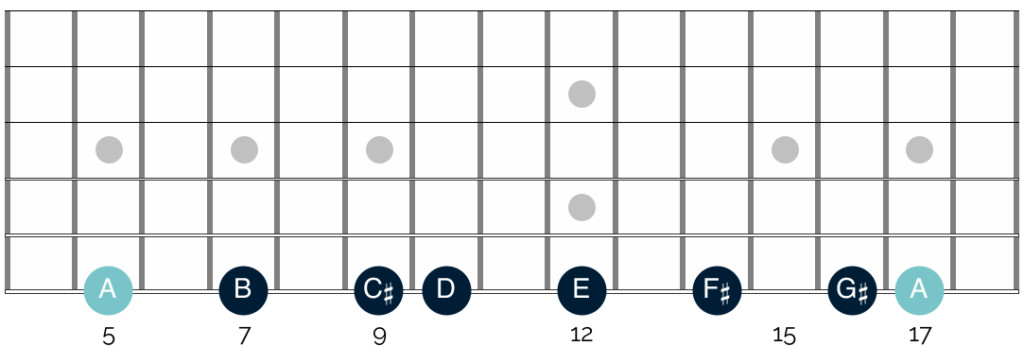 A Major guitar scale
A Major guitar scale
This linear representation highlights the pattern of whole and half steps (or tones and semitones) that define the major scale. Specifically, the fretboard spacing follows this sequence:
Whole step | Whole step | Half step | Whole step | Whole step | Whole step | Half step
Many guitarists find it helpful to vocalize or internalize this step pattern when initially learning the scale. This rhythmic approach can be a valuable tool for memorizing the note pattern, which possesses a distinct sonic character compared to other scales you might be familiar with.
As a reminder, here are the five common shapes of the A major scale as they lay across the fretboard:
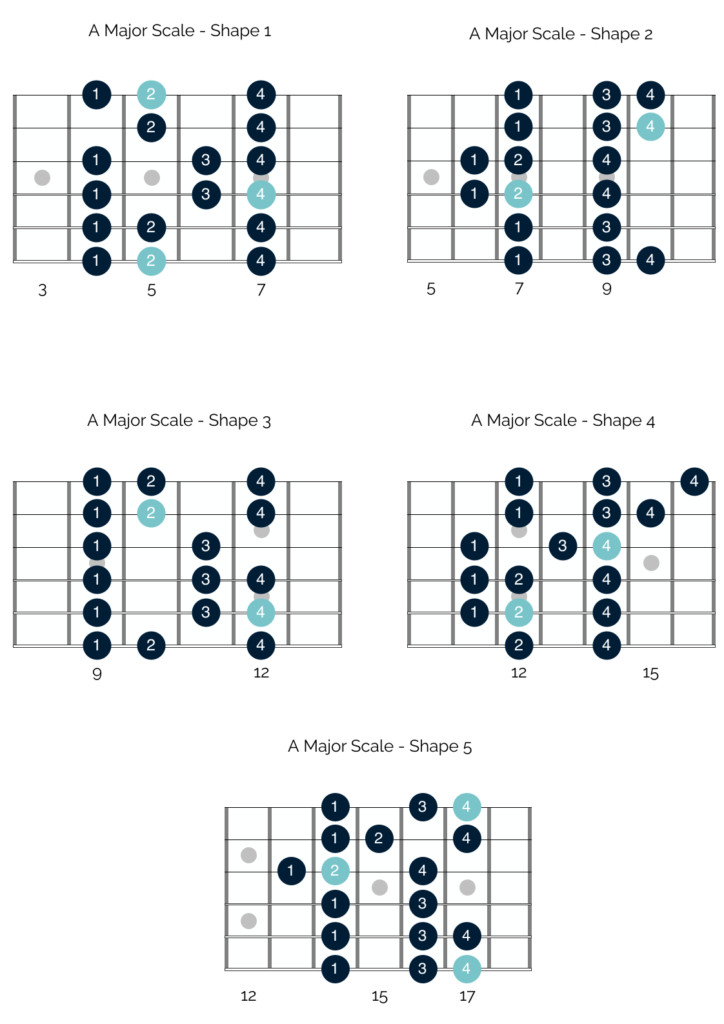 Major scale shapes are essential for understanding modes on guitar
Major scale shapes are essential for understanding modes on guitar
As detailed previously, various fingerings can be employed for these shapes. The fingerings presented here are widely considered effective for blues and blues rock guitarists. The tonic notes (A in this example) are highlighted in light blue.
Unlike some other guitar scales, the major scale isn’t always immediately intuitive to apply in your playing, especially in genres like blues and blues rock. While foundational, you may find yourself gravitating more towards modes in these styles.
[Placeholder for Banner Ad]
Deciphering Guitar Modes
Modes are essentially a family of scales derived from the major scale. They utilize the exact same notes as their parent major scale. The crucial distinction lies in that each mode begins on a different note of the major scale.
This seemingly simple shift in the starting point has a profound impact on the intervals between the notes within the scale. This alteration in interval relationships is what gives each mode its unique sound and character, even though they share the same set of notes.
This is the core concept to grasp when learning modes. It’s a point we’ll explore in greater depth. However, a quick example can illuminate this idea before we delve further. Let’s revisit the A major scale:
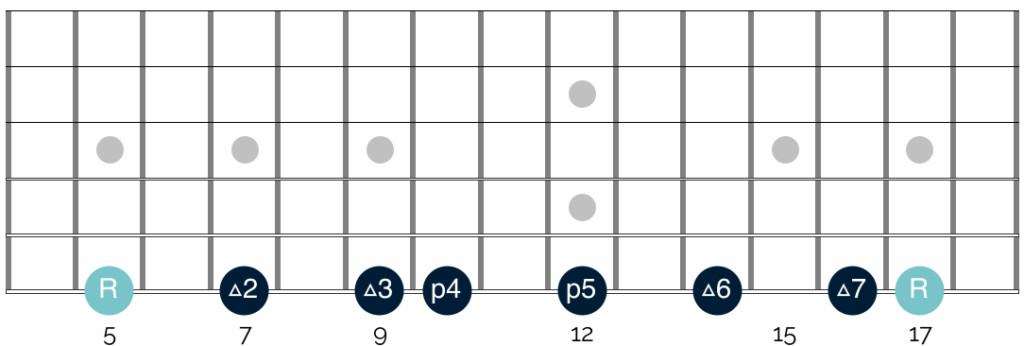 Understanding modes requires grasping the major scale first
Understanding modes requires grasping the major scale first
This diagram illustrates the notes and intervals of the A major scale. Starting on A and ascending through the scale yields the intervals shown.
Now, imagine maintaining the same notes but shifting the starting point to B instead of A. Observe how all the intervals between the notes change:
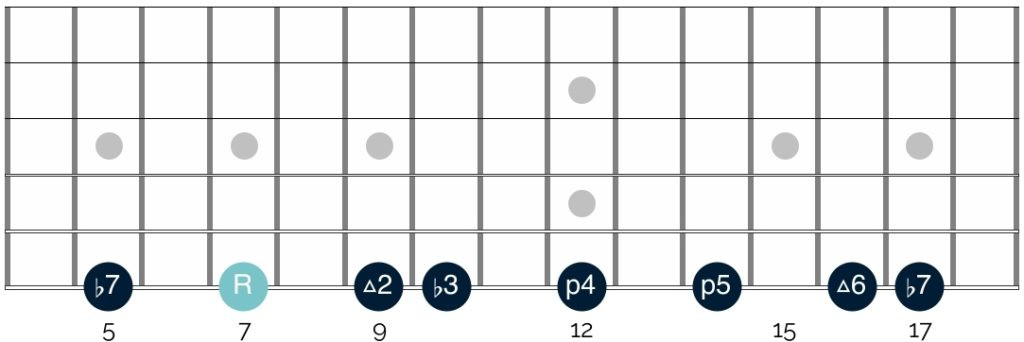 B Dorian scale demonstrates how modes change the tonal center
B Dorian scale demonstrates how modes change the tonal center
Notice that the notes in this second diagram are identical to those in the A major scale diagram. The sole difference is the designated root note: B instead of A. This seemingly minor change has a cascading effect, altering the intervals and fundamentally transforming the scale’s sound and function.
This concept will become clearer as we examine each mode individually. However, this example hopefully highlights the crucial idea that the starting note defines the mode’s character.
Before we explore the specific modes, let’s establish some fundamental facts about them.
The Foundational Elements of Modes
There are seven modes in total, each built upon one of the seven notes of the major scale. There’s a mode originating from the second note, another from the third, and so on, for each degree of the major scale.
One initial hurdle in understanding modes is their Greek names. The names of the modes, in their sequence derived from the major scale, are:
| Ionian | Dorian | Phrygian | Lydian | Mixolydian | Aeolian | Locrian |
|---|
Helpfully, there are mnemonics to aid in memorizing the names and order of the modes. Two popular examples are:
- I Don’t Particularly Like Modes A Lot
- I Don’t Particularly Like My Aunt Lucy
While immediate memorization of the modal order isn’t essential, familiarizing yourself with the names early on is beneficial.
This familiarity eases you into the vocabulary of modes and mitigates initial confusion arising from their unfamiliar names.
Let’s now turn to the construction of modes to understand their individual structures, characteristics, and how to play them on guitar.
Constructing the Modes
As mentioned, each of the seven modes stems from a degree of the major scale. Ionian mode is based on the first degree, Dorian on the second, Phrygian on the third, and so on.
If we start with the A major scale, the modes derived from it are:
| A Ionian | B Dorian | C♯ Phrygian | D Lydian | E Mixolydian | F# Aeolian | G# Locrian |
|---|
Each mode is built upon a new root note, and the scale is then understood in relation to that root.
Even though we begin with the A major scale and technically use its notes throughout the modal sequence, we don’t end up with A Dorian, A Phrygian, etc. Instead, we get B Dorian, C♯ Phrygian, and so forth.
Understanding this distinction is vital for grasping how modes relate to each other and how to navigate and utilize them in your guitar playing.
This principle applies across all major keys. For example, in C major, the notes are:
C D E F G A B
Modes derived from C major will yield a different set of root notes than those from A major. You’ll get D Dorian, E Phrygian, F Lydian, and so on. Starting this process in E major or G major would produce yet another set of modal root notes.
This can initially sound complex, but don’t be discouraged. Grasping every nuance immediately isn’t necessary.
For now, the key takeaway is that within any major key, Ionian mode starts on the first degree, Dorian on the second, Phrygian on the third, and so forth.
The Interplay of Modes and Chords
The final theoretical piece to address before examining each mode individually is chord construction. As discussed in detail elsewhere, harmonizing the notes of the major scale into triads results in a specific sequence of chord qualities:
| Major | Minor | Minor | Major | Major | Minor | Diminished |
|---|
In A major, this harmonization process yields the following chords:
| A major | B minor | C♯ minor | D major | E major | F# minor | G# diminished |
|---|
Just as modes are based on the degrees of the major scale (first, second, third, etc.), the chords follow the same pattern. The ‘i’ chord in B Dorian is B minor. In C♯ Phrygian, it’s C♯ minor, and so on.
The significance of this relationship will become clearer. For now, it’s important to keep this connection between modes and their corresponding chords in mind.
With these foundational concepts established, let’s explore each mode in detail to understand its construction and sonic character.
Ionian Mode
The first mode, Ionian, is the most straightforward to understand because it is, in fact, identical to the major scale.
The terms ‘Ionian mode’ and ‘major scale’ are interchangeable; they represent the exact same scale. In practice, guitarists far more commonly refer to it as the ‘major scale’ than the ‘Ionian mode’.
Ionian mode is a major mode, characterized by an upbeat, bright, and happy sound. It also possesses a triumphant and grand quality, making it a staple in classical music and film scores. Key characteristics of the Ionian mode are:
| Scale Formula | 1 2 3 4 5 6 7 |
|---|---|
| Notes in A Ionian | A B C♯ D E F# G# |
| Chords | A major, B minor, C♯ minor, D major, E major, F# minor, G# diminished |
The first shape of the Ionian mode in A major looks like this (tonic notes in light blue):
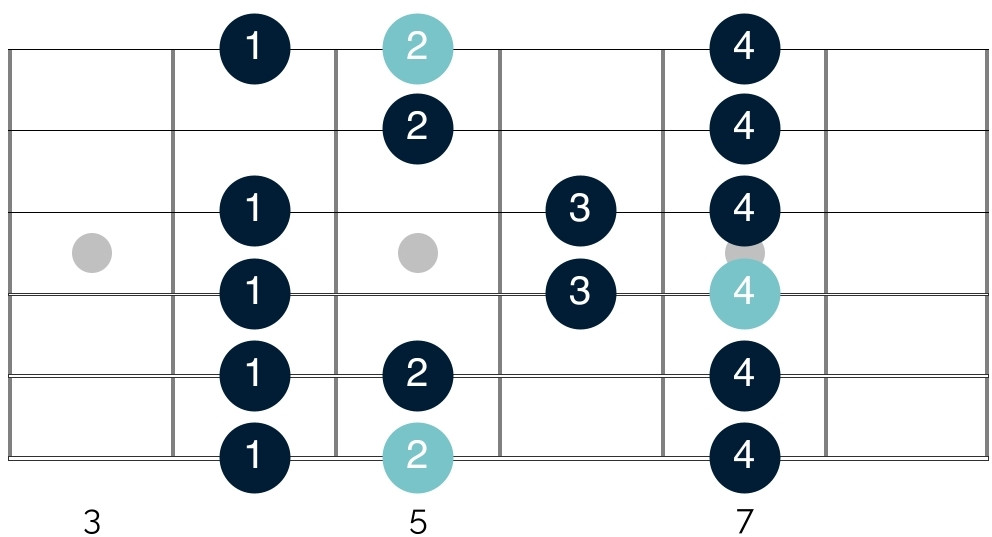 Ionian mode is synonymous with the major scale
Ionian mode is synonymous with the major scale
And here’s the sound of the A Ionian mode played over its tonic chord of A major: [Audio Sample of A Ionian over A major chord]
Due to its bright and cheerful nature, Ionian mode is less frequently used in blues or rock music. However, it does appear in various songs across genres. Examples include:
Despite these examples, Ionian mode remains more prevalent in classical music. For a powerful demonstration of its triumphant sound, listen to pieces like ‘Raider’s March’ or ‘Superman March,’ both composed by John Williams.
Dorian Mode
The second mode of the major scale is Dorian. In contrast to Ionian, Dorian is a minor mode, giving it a more subdued sound. However, compared to other minor modes, Dorian isn’t particularly melancholic or dark.
It has a laid-back, relaxed feel, making it one of the most frequently used modes, especially in genres like jazz, funk, and even blues. Key features of the Dorian mode:
| Scale Formula | 1 2 b3 4 5 6 b7 |
|---|---|
| Notes in B Dorian | B C♯ D E F# G# A |
| Chords | B minor, C♯ minor, D major, E major, F# minor, G# diminished, A major |
The first shape of the Dorian mode on guitar (tonic notes in light blue):
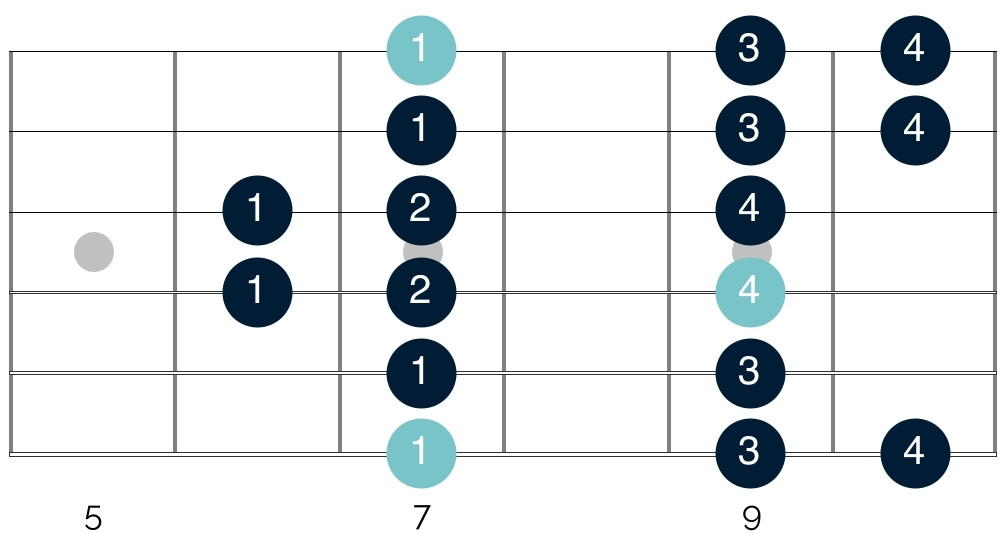 Dorian mode is the second mode and has a minor tonality
Dorian mode is the second mode and has a minor tonality
Listen to the sound of B Dorian over its tonic chord of B minor: [Audio Sample of B Dorian over B minor chord]
The Dorian mode’s sound is noticeably different from Ionian, even though they share the same notes. The change in tonic (from A to B) alters the intervallic relationships. Dorian features a b3 interval (making it minor) and a b7.
These two intervals create the minor character, but the remaining intervals are major or perfect, preventing Dorian from sounding overly dark or intensely minor.
This balance contributes to Dorian’s widespread appeal. It’s prevalent in funk, with notable examples including:
Dorian’s versatility extends beyond funk. It can be highly effective in blues and blues rock, adding a unique flavor to improvisations. Carlos Santana frequently utilizes Dorian in his solos. ‘Evil Ways’ and ‘Oye Como Va’ are prominent examples rooted in Dorian mode. David Gilmour also masterfully employs Dorian; the iconic ‘Another Brick In The Wall Pt. II’ is based on Dorian.
[Placeholder for Banner Ad]
Phrygian Mode
Phrygian, like Dorian, is a minor mode. However, it possesses a significantly heavier and darker sound than Dorian. Key characteristics of Phrygian mode:
| Scale Formula | 1 b2 b3 4 5 b6 b7 |
|---|---|
| Notes in C♯ Phrygian | C♯ D E F# G# A B |
| Chords | C♯ minor, D major, E major, F# minor, G# diminished, A major, B minor |
The first shape of the Phrygian mode on guitar:
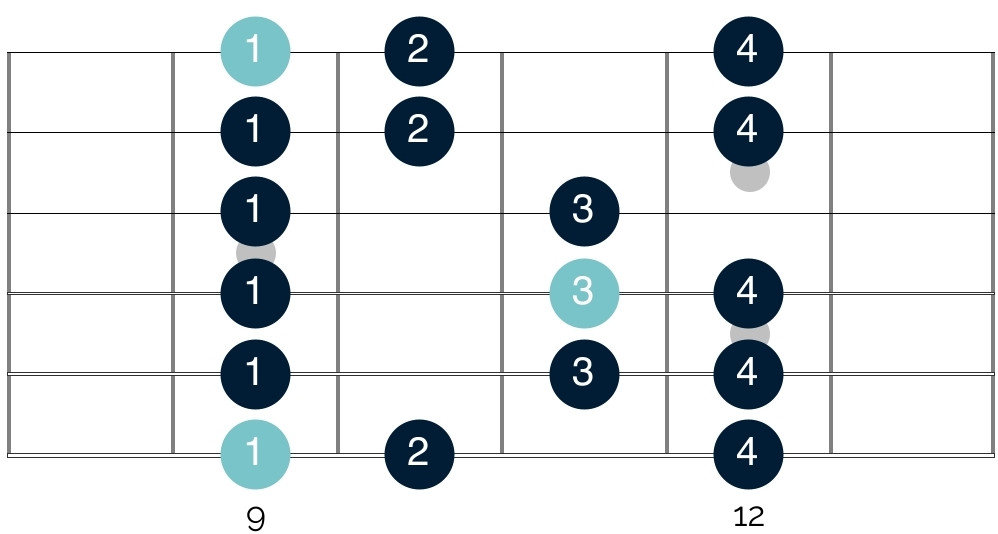 Phrygian mode is a darker minor mode with a b2
Phrygian mode is a darker minor mode with a b2
Listen to the sound of C♯ Phrygian over its tonic chord of C♯ minor: [Audio Sample of C# Phrygian over C# minor chord]
Phrygian’s sound is more intense and ‘heavy’ than Dorian. Consequently, it’s less common in blues (blues or blues rock songs significantly using Phrygian are rare).
Instead, Phrygian finds greater application in heavy metal. Notable songs featuring Phrygian mode include:
The b2 interval inherent in Phrygian also imparts an exotic flavor. While this sound may not perfectly align with blues, it can be very effective depending on the musical context and style you aim to create.
Lydian Mode
Lydian, like Ionian, is a major mode, and its scale formula is very similar to Ionian’s. Key elements of Lydian mode:
| Scale Formula | 1 2 3 #4 5 6 7 |
|---|---|
| Notes in D Lydian | D E F♯ G♯ A B C♯ |
| Chords | D major, E major, F♯ minor, G♯ diminished, A major, B minor, C♯ minor |
The only difference between Ionian and Lydian is the #4 interval in Lydian. Despite this single note difference, their characters diverge significantly.
Lydian, like Ionian, has a happy and bright tonality. However, Lydian’s triumphant and grandiose feel is replaced by a more mystical and ethereal quality.
The first shape of the Lydian mode on guitar:
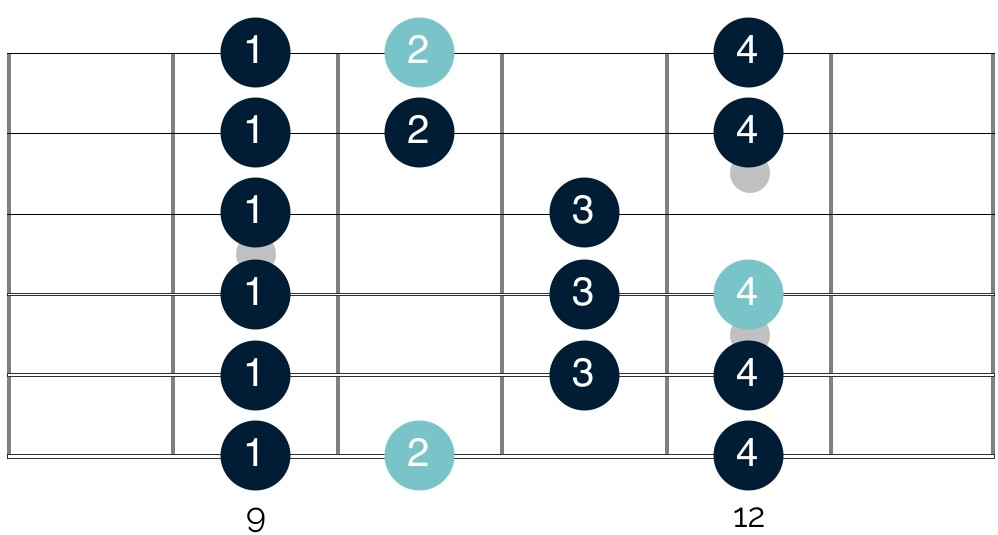 Lydian mode is a major mode with a mystical sound due to the #4
Lydian mode is a major mode with a mystical sound due to the #4
Listen to D Lydian over its tonic chord of D major: [Audio Sample of D Lydian over D major chord]
The #4 interval is the defining characteristic of Lydian, lending it its distinctive ‘otherworldly’ sound. Musicians often emphasize this interval to create this effect in their compositions. Examples of songs using Lydian mode:
This ethereal quality, while beautiful and intriguing, is less suited to blues or blues rock. If these genres are your primary interest, you’re unlikely to encounter Lydian frequently.
Mixolydian Mode
Mixolydian mode, similar to Lydian, is also a major mode. And like Lydian, it differs from Ionian by only one note. Key features of Mixolydian mode:
| Scale Formula | 1 2 3 4 5 6 b7 |
|---|---|
| Notes in E Mixolydian | E F♯ G♯ A B C♯ D |
| Chords | E major, F♯ minor, G♯ diminished, A major, B minor, C♯ minor, D major |
The sole difference here is the b7 interval in Mixolydian. As with Lydian, this single note alters the mode’s feel and character.
The b7 in Mixolydian tempers the pure happiness of Ionian, introducing a bluesier, tenser edge. This makes it an excellent choice for blues and rock guitarists.
The first shape of the Mixolydian mode on guitar:
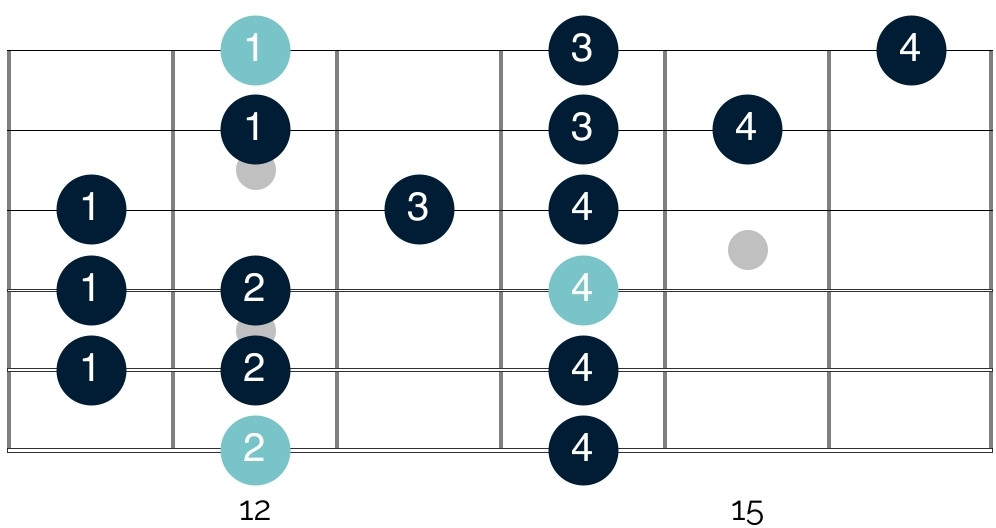 Mixolydian mode is a major mode with a bluesy edge due to the b7
Mixolydian mode is a major mode with a bluesy edge due to the b7
Listen to E Mixolydian over its tonic chord of E major: [Audio Sample of E Mixolydian over E major chord]
Mixolydian can be seen as a hybrid of the major scale and the blues scale. It’s ideal for soloing and improvising in a major blues context, adding depth and complexity to your playing. Examples of songs using Mixolydian mode:
Mixolydian’s sound is perfectly suited for creating upbeat blues and blues rock. AC/DC’s extensive use of Mixolydian has become a defining element of their sound.
Aeolian Mode
Aeolian mode, also known as the natural minor scale or relative minor scale, is a minor mode. Its sound falls between Dorian and Phrygian. It’s more melancholic and downbeat than Dorian, with a slightly sharper and more aggressive edge.
However, it’s not as intensely dark or heavy as Phrygian. Key characteristics of Aeolian mode:
| Scale Formula | 1 2 b3 4 5 b6 b7 |
|---|---|
| Notes in F♯ Aeolian | F♯ G♯ A B C♯ D E |
| Chords | F♯ minor, G♯ diminished, A major, B minor, C♯ minor, D major, E major |
The first shape of the Aeolian mode on guitar:
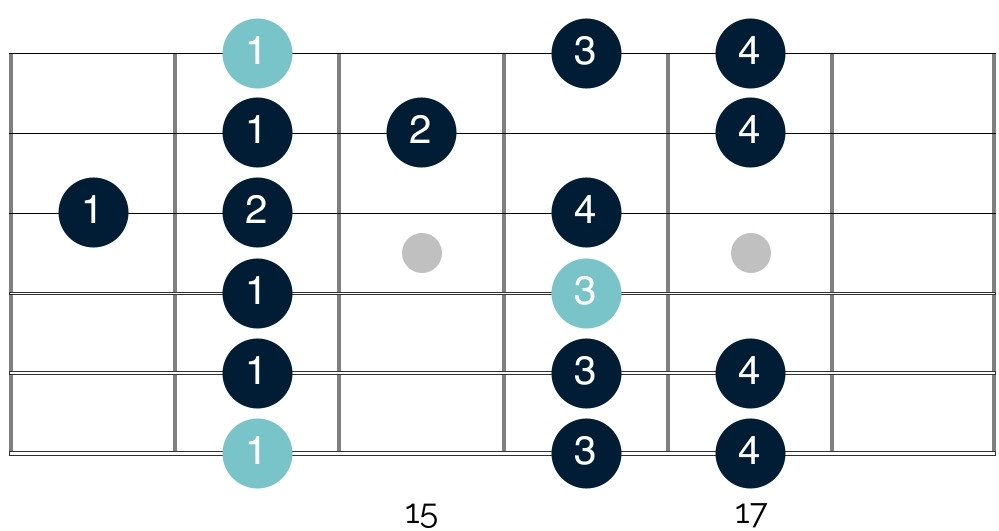 Aeolian mode is the natural minor scale and is widely used in blues and rock
Aeolian mode is the natural minor scale and is widely used in blues and rock
Listen to F♯ Aeolian over its tonic chord of F♯ minor: [Audio Sample of F# Aeolian over F# minor chord]
Like Mixolydian, Aeolian is widely used in blues and blues rock, making it a mode you’ll likely encounter frequently.
Aeolian is particularly valuable for adding depth and color to minor blues improvisations. Examples of songs using Aeolian mode:
Just as Mixolydian excels in a major blues context, Aeolian is a prime choice for soloing over a minor blues progression.
Locrian Mode
The final mode, Locrian, is largely theoretical. Many musicians and composers dismiss it for practical application due to its inherently tense and unresolved sound.
Like Dorian, Phrygian, and Aeolian, Locrian is a minor mode. The crucial difference is that the tonic chord associated with Locrian is diminished.
Diminished chords have a dissonant quality, and consequently, the Locrian mode as a whole is quite jarring. Key features of Locrian mode:
| Scale Formula | 1 b2 b3 4 b5 b6 b7 |
|---|---|
| Notes in G♯ Locrian | G♯ A B C♯ D E F♯ |
| Chords | G♯ diminished, A major, B minor, C♯ minor, D major, E major, F♯ minor |
The first shape of the Locrian mode on guitar:
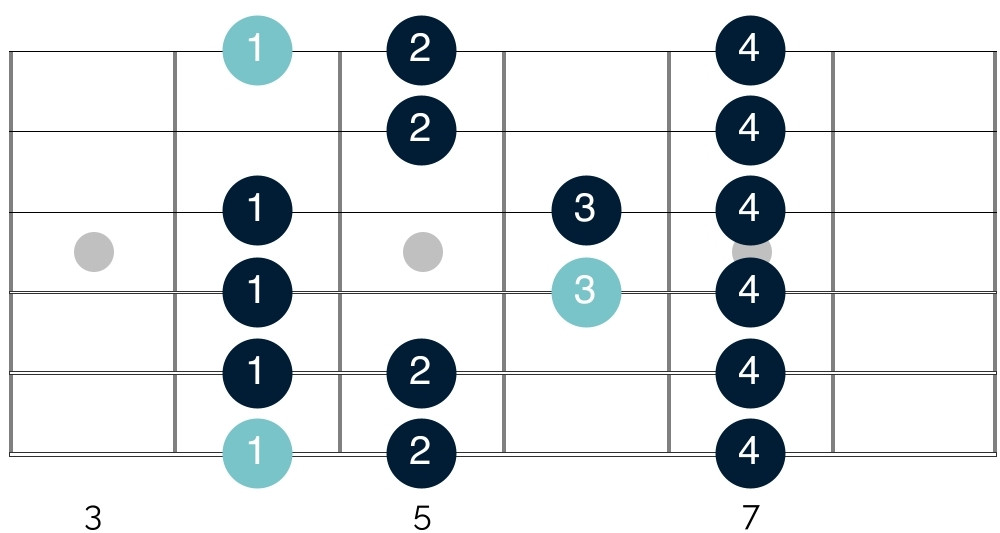 Locrian mode is a theoretical mode with a diminished tonic and dissonant sound
Locrian mode is a theoretical mode with a diminished tonic and dissonant sound
Listen to G♯ Locrian over its tonic chord of G♯ diminished: [Audio Sample of G# Locrian over G# diminished chord]
Finding songs purely based on Locrian mode is challenging. The diminished tonic chord lacks resolution, disrupting the sense of resolution typically desired in music. This lack of resolution explains why Locrian is rarely used in songwriting. Examples that incorporate elements of Locrian include:
These songs feature elements of Locrian but are not purely built around it, unlike some examples provided for other modes.
Unless you’re interested in creating intensely dissonant music, Locrian is unlikely to be practically useful. Its inclusion here is for completeness, providing a comprehensive understanding of all seven guitar modes.
[Placeholder for Banner Ad]
Modal Scale Shapes – Part 1
Hopefully, you now have a clearer grasp of the theory behind modes and can discern the unique character of each. However, this theoretical knowledge doesn’t yet translate to playing modes on your guitar.
The excellent news is that you don’t need to learn entirely new scale shapes to play modes.
The familiar scale shapes of the major scale (Ionian mode) are exactly the same shapes used for the remaining six modes. Comparing the major scale diagrams with the individual modal shapes confirms this.
A closer look reveals the relationships between modal scale shapes, which will help you start playing modes on your guitar. Let’s explore these relationships in detail.
The relationship between modal scales and major scale shapes is as follows:
The Dorian mode, being the second mode of the major scale, starts with the second shape of the major scale. When playing Dorian, you utilize the same shapes as the major scale, but the sequence shifts.
What was shape 3 in the major scale becomes shape 2 in Dorian. Shape 4 in major becomes shape 3 in Dorian, and so on.
Following guitar scale shape conventions, after shape 5, you cycle back to shape 1. So, in Dorian mode, you begin with major scale shape 2, then play shapes 3, 4, 5, and 1.
Similarly, the Phrygian mode, the third mode of the major scale, starts with the third major scale shape. Again, the shapes are identical to the major scale, but the sequence shifts by two degrees.
Shape 4 in the major scale becomes shape 2 in Phrygian. Shape 5 in major becomes shape 3 in Phrygian, and so on.
As with Dorian, after major scale shape 5 in Phrygian, you revert to shape 1. Thus, in Phrygian mode, you start with major scale shape 3, followed by shapes 4, 5, 1, and 2.
Modal Scale Shapes – Part 2
Since there are only five primary major scale shapes (using closed fingerings), but seven modes, this pattern can’t continue linearly through all modes.
If this pattern were to continue, by the sixth mode, you’d loop back to the first major scale shape.
Therefore, there are two points where this pattern slightly diverges.
The first divergence occurs with the Lydian mode. The scale shapes and their order in Lydian are identical to those in Phrygian mode. The key difference is that these shapes are rooted in different tonic notes. Let’s compare the first shape of both:
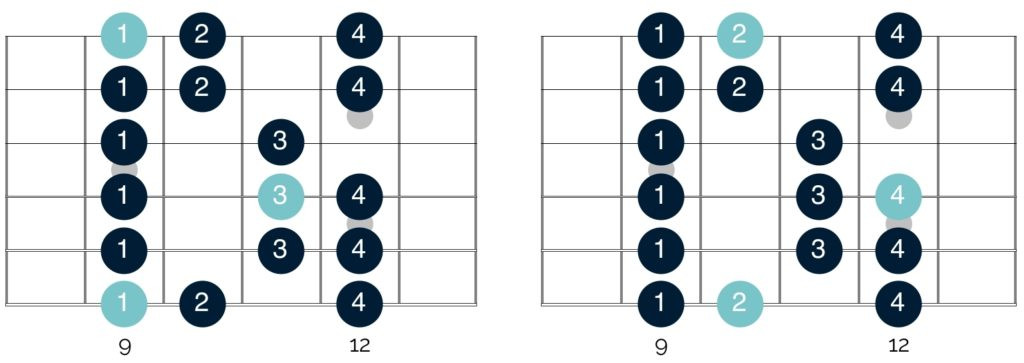 Lydian and Phrygian modes share the same shapes but different root notes
Lydian and Phrygian modes share the same shapes but different root notes
The left diagram shows Phrygian mode; the right shows Lydian. The shapes and fretboard positions are identical. The distinction is the root note: C♯ for Phrygian and D for Lydian.
The same relationship exists between Ionian and Locrian modes. Their scale shapes and order are identical. The difference lies in their tonic notes. Comparing their first shapes:
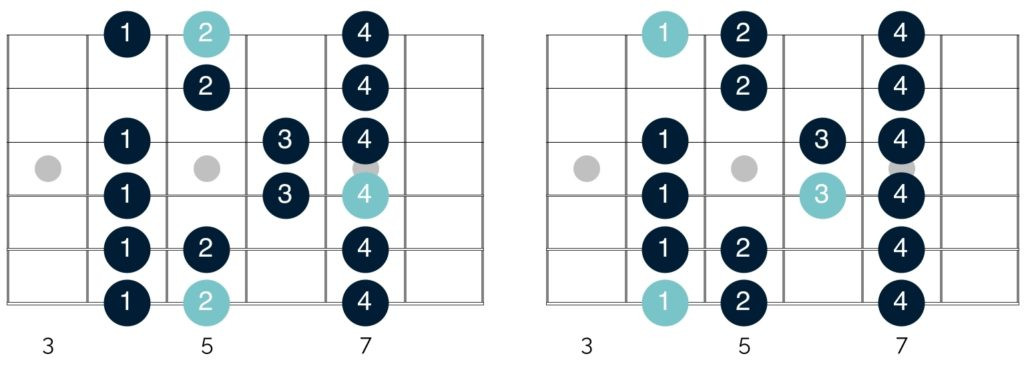 Ionian and Locrian modes also share shapes but differ in root notes
Ionian and Locrian modes also share shapes but differ in root notes
The left diagram is Ionian, the right is Locrian. Again, shapes and positions are identical. The root note is A for Ionian and G♯ for Locrian.
Modes in Context
This shift in root note only becomes musically relevant within a proper musical context.
Playing the scale shapes from the diagrams consecutively – Phrygian then Lydian, or Ionian then Locrian – will sound identical in each pair.
They only differentiate themselves when placed within a musical context. This is true for all modes and is a crucial point for utilizing modes effectively in your playing.
Each mode’s characteristic sound emerges when played in its intended musical context. To create the sound of B Dorian, play Dorian scale shapes over a B minor chord. For C♯ Phrygian, play Phrygian shapes over a C♯ minor chord.
Without this contextual grounding, the modal scale you play will sound like the mode associated with the chord you’re playing over. This may seem complex, but examples will clarify this:
Playing the first shape of B Dorian over a B minor chord produces the Dorian sound: [Audio Sample of B Dorian over B minor chord]
Conversely, playing the identical shape over an A major chord will evoke the A Ionian mode: [Audio Sample of the same shape over A major chord, sounding Ionian]
The notes of B Dorian and A Ionian are the same. This principle applies to C♯ Phrygian, D Lydian, E Mixolydian, etc. Each scale shape is sonically versatile. Achieving a specific modal sound hinges on understanding the chords and musical context you’re playing within.
Applying Modes to Your Guitar Playing
At this point, you might be wondering how to practically use modes in your guitar playing.
A comprehensive exploration of this topic extends beyond this guide’s scope. It’s a vast subject that will be addressed in more detail in future discussions, particularly focusing on Dorian, Mixolydian, and Aeolian, the modes most relevant to blues and blues rock.
Here, we’ll cover fundamental points to get you started.
Let’s recap all the modes and their attributes:
| Mode | Ionian | Dorian | Phrygian | Lydian | Mixolydian | Aeolian | Locrian |
|---|---|---|---|---|---|---|---|
| Scale Formula | 1 2 3 4 5 6 7 | 1 2 b3 4 5 6 b7 | 1 b2 b3 4 5 b6 b7 | 1 2 3 #4 5 6 7 | 1 2 3 4 5 6 b7 | 1 2 b3 4 5 b6 b7 | 1 b2 b3 4 b5 b6 b7 |
| Notes in A major | A B C♯ D E F# G# | B C♯ D E F# G# A | C♯ D E F# G# A B | D E F# G# A B C♯ | E F# G# A B C♯ D | F# G# A B C♯ D E | G# A B C♯ D E F# |
| Chords | A, Bm, C#m, D, E, F#m, G#mb5 | Bm, C#m, D, E, F#m, G#mb5, A | C#m, D, E, F#m, G#mb5, A, Bm | D, E, F#m, G#mb5, A, Bm, C#m | E, F#m, G#mb5, A, Bm, C#m, D | F#m, G#mb5, A, Bm, C#m, D, E | G#mb5, A, Bm, C#m, D, E, F#m |
| Tonality | Major | Minor | Minor | Major | Major | Minor | Minor/Diminished |
Using this table, we can explore how to use modes for both soloing and rhythm guitar.
Soloing with Modes
To begin improvising with modes, determine the key you’re playing in and its tonality (major or minor). This will guide your modal choices.
In a minor key, you have three minor mode options: Dorian, Phrygian, and Aeolian.
In a major key, you have three major mode options: Ionian, Lydian, and Mixolydian.
Locrian, as noted, is primarily theoretical and rarely used in practical playing.
Your mode selection depends on the desired feel and the underlying chords. Chord choice is a complex aspect beyond this introduction.
For now, ensure the chosen modal scale aligns with the chord you’re playing over. For example, use D Lydian over a D major chord (or similar major chord). Use C♯ Phrygian over a C♯ minor chord (or similar minor chord).
Remember these concepts extend beyond A major.
To play in D Dorian, for instance, shift your modal scale shapes to reflect the key change. The first shape of D Dorian would look like this:
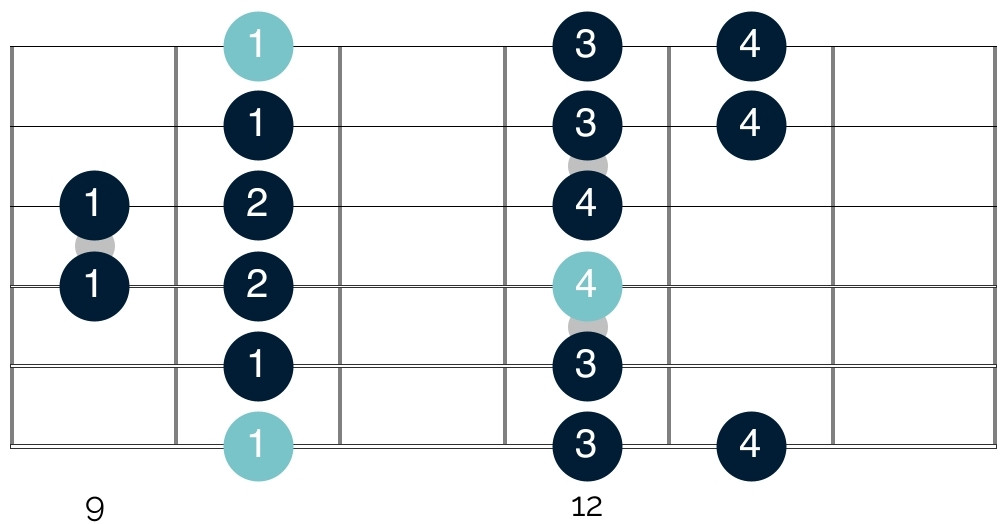 D Dorian scale shape example
D Dorian scale shape example
The D Dorian shape is identical to the B Dorian shape, only shifted in position. This principle applies to all modes. Simply transpose the first shape to the desired root note.
Playing Chords with Modes
Harmonizing the major scale creates seven chords, used in chord progressions. These chords are often referenced with Roman numerals.
In A major, A major is I, B minor is ii, and so on. Uppercase numerals denote major chords, lowercase for minor. Diminished chords are also lowercase, often with a ‘°’ symbol.
Just as modal scales shift through the modes, so do the chords.
In A Ionian, the I, ii, and iii chords are A major, B minor, and C♯ minor.
In B Dorian, the first chord becomes B minor (i), C♯ minor is ii, and D major is III.
This pattern continues through the modes. Comparing chords across modes:
| Mode | Ionian | Dorian | Phrygian | Lydian | Mixolydian | Aeolian | Locrian |
|---|---|---|---|---|---|---|---|
| Notes in A major | A B C♯ D E F# G# | B C♯ D E F# G# A | C♯ D E F# G# A B | D E F# G# A B C♯ | E F# G# A B C♯ D | F# G# A B C♯ D E | G# A B C♯ D E F# |
| Chords | A, Bm, C#m, D, E, F#m, G#mb5 | Bm, C#m, D, E, F#m, G#mb5, A | C#m, D, E, F#m, G#mb5, A, Bm | D, E, F#m, G#mb5, A, Bm, C#m | E, F#m, G#mb5, A, Bm, C#m, D | F#m, G#mb5, A, Bm, C#m, D, E | G#mb5, A, Bm, C#m, D, E, F#m |
| Chord Numbers | I, ii, iii, IV, V, vi, vii° | i, ii, III, IV, v, vi°, VII | i, II, III, iv, v°, VI, vii | I, II, iii, iv°, V, vi, vii | I, ii, iii°, IV, v, vi, VII | i, ii°, III, iv, v, VI, VII | i°, II, iii, iv, V, VI, vii |
Don’t feel overwhelmed by this table. Memorizing specific modal chord sequences isn’t essential at this stage. Focus on understanding how chord progressions shift as you move through modes.
Bringing It All Together
This guide provides a foundation in guitar modes and their application.
If this is new territory, don’t rush. Mastering modes takes time and effort, representing a significant step beyond pentatonic scales, which require less theoretical grounding.
Approach this material gradually. Understanding and effectively using modes involves connecting various music theory concepts. Missing pieces can hinder your overall grasp.
Take your time to truly understand and become comfortable with these concepts before moving forward. This introductory knowledge is crucial for deeper exploration of modes in future discussions.
As with all guitar skills, modes offer vast depth. Future articles will delve into more practical applications of modes, particularly Dorian, Mixolydian, and Aeolian, in blues and blues rock contexts.
A solid grasp of these foundational concepts is essential for continued progress and confident modal application in your playing.
Good luck on your modal journey! Feel free to share your progress or ask questions in the comments or via email at [email protected]. I’m here to help! 😁
References & Images
Unsplash, YouTube, Registry Of Guitar Tutors, YouTube, Ultimate Guitar, YouTube, Guitar World, Wikipedia, YouTube, Premier Guitar, Guitar Theory For Dummies, YouTube, Music Stack Exchange, YouTube, YouTube, Guitar Lesson World, The Practical Guide To Modern Music Theory For Guitarists
